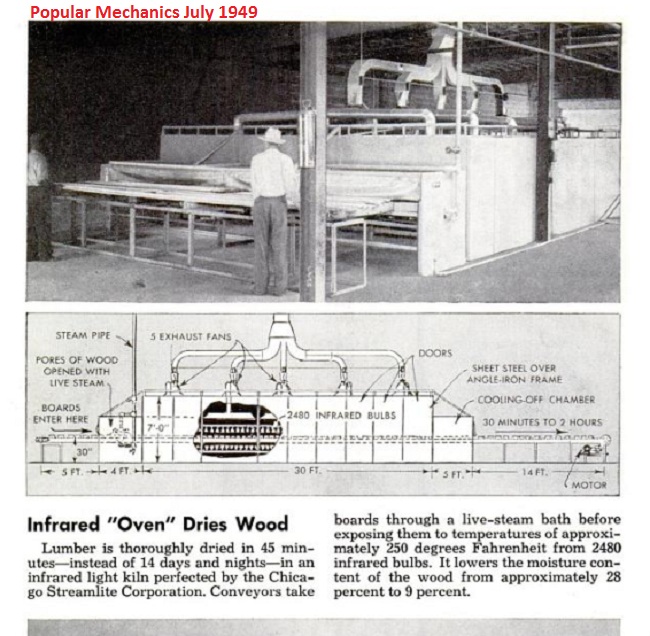Question
I have an opportunity to buy an Incomac kiln tag 100. Does anyone have any feedback about these kilns? The lumber I'm going to dry is white oak.
Forum Responses
(Sawing and Drying Forum)
From Gene Wengert, forum technical advisor:
Are you in the USA or Canada? I have not seen many of their units. Several that I saw were for heat treating pallets and not drying lumber, although they do make lumber drying kilns. (I might have seen some of the kilns in southern Ohio ten years ago.) Make sure that you are getting a legitimate kiln and not a pallet kiln. You might already know that they are an Italian based company that has built a good number of kilns in Europe.
The following applies to any used kiln. The structural integrity, including present insulation value for the walls and roof, is the key. Have an engineer inspect the building. You might also ask the engineer about what he considers the possibility of taking the building apart, moving it and reassembling it.
Next, inspect the heating, humidifying and venting systems. Be confident that you will be able to repair anything that goes wrong with these systems, as sometimes replacement parts from foreign manufacturers are difficult to obtain.
Finally, inspect the controls to make sure that they work and that you can read the instruction book and that the instructions are written in good English and are not a computer translation that makes little sense in English.
You also need to make sure that the kiln is designed for drying the species that you want. A softwood design kiln will not work well with drying oak, for example; an oak design will not work well with maple.
It's my understanding that kilns designed specifically for hardwoods (in general) have side-loading access and don't run as high temps as do softwood kilns. So are softwood kilns in general designed with thicker walls, or somehow built to achieve a higher R value than hardwood chambers?
I'd guess you'd want as much R (efficiency) as you can get for either since hardwoods take considerably longer to dry than do softwoods. If his kiln is designed for hardwoods let's say, and he wants to dry softwoods almost exclusively, couldn't he just add more BTU generation (by whatever means)? Is venting drastically different between the two systems? I realize the schedules are different among most species not just hard vs. softwoods, but that's (software) probably the easiest thing to modify?
Sensing devices (bulbs/probes) are generally capable of accommodating either range. Metering devices (if used) are generally adjustable. Hope this isn't going off topic but you piqued - I've never considered how difficult it might or might not be to 'convert' one design to do the job of the other.
Now this is off topic but I stumbled across this below a few weeks ago and wanted to ask you about it ever since. I guess now's as good a time as any. While this is obviously not feasible (or they would be in use to some degree) is there any merit whatsoever to this claim?

I did research on high temperature drying of hardwoods quite a few years ago and it looked somewhat good for a few species. However, the heat will result in the surface being dried to about 1.5% MC, which then has to be brought back up to 7% MC. Unfortunately, when wood is dried that low and hot, it will not machine well, even though the MC is brought back up. There is strength loss and brittleness.
The other big issue is that the wood will be at a range of MCís, so equalization will be needed and this can mean stickering the lumber, putting it in a kiln or similar at 9% EMC, maybe a small boiler, and maybe 160 F for a few days. Of course, there may also be stress relief required too. With this extra effort, the cost soon becomes unreasonable. Incidentally, electricity is about three times more expensive than wood waste of natural gas, so electric systems without a heat pump can be quite expensive.
Generally a softwood control system will not work for hardwoods, unless it is really versatile. For hardwoods, the controls need to be more precise, need humidification and venting, need ramping, and use equalization and conditioning. Softwood kilns often have more fan power, which might be excessive and unnecessarily expense (electricity cost) for hardwoods.
Softwood kilns might dry at 200 F (sometimes they will go to 240 F), while hardwood run 110 to 160 F mainly. So, heat losses through the walls and roof will be double. Drying time for softwoods might be 1/4 of the time for hardwoods, so overall hardwood kilns will lose more energy per BF through the walls and roof than softwoods. Hence, hardwood kilns should have more insulation. In a softwood kiln, much of the heat loss through the walls actually comes from the condensation of vapor on the cold walls, which actually saves money.
Another difference is that some softwood kilns have vent heat exchanger to collect the vent energy (maybe 75% of the energy used in drying is going out the vents). With hardwoods, the drying rate is so slow that vent heat savings are harder to show an economic advantage.